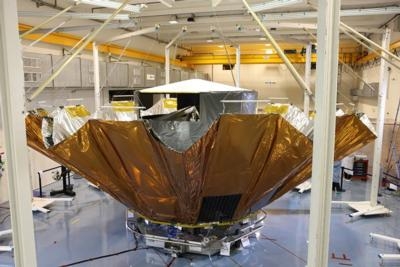Mon, Oct 14, 2013
Surveyor Will Be First Deep-Space Probe Boosted Aboard An Arianespace Soyuz Rocket
Payload preparations for Arianespace’s next Soyuz launch are progressing well at the Spaceport in French Guiana, where the Gaia billion-star surveyor is receiving its sunshield for in-orbit telescope protection as well as power generation. This sunshield is one of the final elements in completing the European Space Agency’s Gaia, the installation of which has been performed by the assembly, integration and testing team of prime contractor Astrium – with support from Spain’s SENER, which produced the sunshield.

The latest activities involved placement of the inner thermal blankets for Gaia’s multi-layer sunshield insulation, as well as incorporation of solar array panels that will provide energy to power all on-board electronics. Both elements are positioned on the sunshield’s carbon-fiber reinforced composite framework, which also was integrated at the Spaceport.
When the sunshield’s 12 folding frames are opened in orbit after launch by Arianespace’s Soyuz, the fully-insulated sunshield will form a flat disc at the base of Gaia – shading its telescope from the sun and maintaining the spacecraft’s scientific instruments at a constant temperature of approximately -100 degrees Celsius. This will allow Gaia to perform its ambitious mission of making the largest, most precise three-dimensional map of the Milky Way by surveying an unprecedented one percent of its 100 billion stars.
The solar array panels fixed to the sunshield will provide approximately 1,850 Watts of electrical power, to be used by Gaia for powering the data processing computers, along with the communications, navigation and thermal control systems. A massive amount of data will be collected over Gaia’s planned five-year mission, with its full archive to exceed 1 petabyte in size – providing enough information to answer questions related to the origin, structure and evolutionary history of the galaxy.

Gaia will be orbited on Arianespace’s Flight VS06, which is scheduled for liftoff on November 20 from the Spaceport. As indicated by the company’s launcher family numbering designation, this will be the Spaceport’s sixth liftoff with medium-lift vehicle since its introduction at French Guiana in October 2011 by Arianespace.
After being deployed by Soyuz, the hexagonal/conical-shaped spacecraft will follow a flight path to an orbit around the Sun at the second Lagrange point (L2) – a distance of about 1 million miles from Earth. This makes Gaia the first deep space payload launched by Arianespace with Soyuz from the Spaceport.
(Images provided by Arianespace)
More News
Takeoff Roll The process whereby an aircraft is aligned with the runway centerline and the aircraft is moving with the intent to take off. For helicopters, this pertains to the act>[...]
“We’re proud of the hard work that went into receiving this validation, and it will be a welcome relief to our customers in the European Union. We couldn’t be mor>[...]
"Aircraft Spruce is pleased to announce the acquisition of the parts distribution operations of Wag-Aero. Wag-Aero was founded in the 1960’s by Dick and Bobbie Wagner in the >[...]
IDENT Feature The special feature in the Air Traffic Control Radar Beacon System (ATCRBS) equipment. It is used to immediately distinguish one displayed beacon target from other be>[...]
Aero Linx: Pararescue Air Force Pararescuemen, also known as PJs, are the only DoD elite combat forces specifically organized, trained, equipped, and postured to conduct full spect>[...]
 ANN's Daily Aero-Term (05.10.24): Takeoff Roll
ANN's Daily Aero-Term (05.10.24): Takeoff Roll Aero-News: Quote of the Day (05.10.24)
Aero-News: Quote of the Day (05.10.24) Aero-News: Quote of the Day (05.11.24)
Aero-News: Quote of the Day (05.11.24) ANN's Daily Aero-Term (05.11.24): IDENT Feature
ANN's Daily Aero-Term (05.11.24): IDENT Feature ANN's Daily Aero-Linx (05.11.24)
ANN's Daily Aero-Linx (05.11.24)




